Evolution of Inter-University Research Collaboration in the Chengdu–Chongqing Economic Circle (2005–2024): A Biblio-Metric Perspective
Abstract
1. Introduction
- How has research collaboration among CCEC universities evolved, and which institutions occupy central positions within the collaboration network?
- What are the major thematic areas of inter-university research collaboration, and how have these themes evolved over time?
- What are the structural characteristics of author-level collaboration within the CCEC, and how have they changed over time?
2. Literature Review
3. Data and Methods
3.1. Research Methods
- (1)
- Co-authored Publications. The network of collaboration was constructed based on co-authored publications, defined as papers jointly published by two or more universities. Co-authorship provides a direct and widely accepted proxy for measuring actual research collaboration between institutions (Glänzel & Schubert, 2005; Katz & Martin, 1997).
- (2)
- Betweenness Centrality. In social network analysis, betweenness centrality measures the extent to which a node lies on the shortest paths connecting other nodes (Freeman, 1977). It reflects a university’s bridging capability in facilitating information and knowledge flow within the collaboration network. A higher betweenness centrality value indicates that the institution is playing a crucial role in connecting otherwise isolated research clusters and facilitating cross-institutional collaboration (Chen, 2006; Newman, 2001). In this study, it was calculated using CiteSpace 6.4.R2.
- (3)
- Citation Bursts. The strongest citation bursts were detected using CiteSpace’s burst detection algorithm (Kleinberg, 2003). A citation burst indicates a rapid increase in the frequency with which a keyword or reference is cited during a given period, highlighting emerging research frontiers or shifts in thematic focus (Chen, 2012).
3.2. Research Data
3.3. Data Analysis
4. Results and Discussion
4.1. Temporal Distribution of Publications
4.2. Overall Collaboration Network Analysis
4.3. Thematic Co-Occurrence Cluster Network Analysis
4.4. Analysis of the Author Collaboration Network
5. Conclusions
- (1)
- Policy-driven evolution of collaboration. The development of university collaboration in the CCEC aligns closely with major national strategies. Collaborative publications increased sharply after these initiatives, confirming that policy interventions and funding incentives have been central to stimulating cross-institutional research integration.
- (2)
- Centralization of the collaboration network around core universities. Leading universities—SCU, UESTC, and CQU—occupy dominant positions in the collaboration network. Their high betweenness centrality demonstrates their bridging role in linking diverse research teams and fields. These institutions function as regional innovation anchors, providing critical platforms for research coordination and talent mobility.
- (3)
- Expanding interdisciplinary frontiers. Thematic co-occurrence analysis shows that collaborative research has diversified beyond traditional fields such as chemistry and engineering, extending into environmental science, materials, and applied mathematics. This transition toward interdisciplinary integration reflects the region’s adaptive response to the national “innovation-driven development” strategy and the demand for cross-sectoral problem-solving capacity.
- (4)
- Uneven network integration. Despite growing author collaboration, peripheral institutions remain weakly connected, suggesting structural imbalances within the regional innovation system. This fragmentation limits knowledge diffusion and reduces the overall efficiency of the collaboration network.
- (1)
- Embed collaboration in institutional frameworks. Universities and regional authorities should institutionalize cross-university cooperation through formalized alliances, joint laboratories, and co-funded research centers. These initiatives can be coordinated under national programs such as the Double First-Class University Plan or Western Innovation Hub Construction to ensure sustained financial and policy support.
- (2)
- Align funding mechanisms with collaborative performance. The Ministry of Education, the Ministry of Science and Technology, and local governments should design funding schemes that explicitly reward inter-institutional and interdisciplinary collaboration. For instance, adjusting the National Natural Science Foundation of China (NSFC) evaluation criteria to emphasize collaborative outcomes can incentivize deeper regional partnerships.
- (3)
- Strengthen policy coordination and innovation governance. A regional-level innovation coordination committee could be established to harmonize university–industry–government interactions, facilitate joint project management, and monitor collaboration performance. Integrating innovation indicators into local performance evaluation systems can further enhance accountability and network sustainability.
Author Contributions
Funding
Institutional Review Board Statement
Informed Consent Statement
Data Availability Statement
Conflicts of Interest
Appendix A
| NO. | University Name | Location |
|---|---|---|
| 1 | Chengdu Medical College | Chengdu, Sichuan Province |
| 2 | Chengdu Normal University | Chengdu, Sichuan Province |
| 3 | Chengdu Sport University | Chengdu, Sichuan Province |
| 4 | Chengdu Technological University | Chengdu, Sichuan Province |
| 5 | Chengdu University | Chengdu, Sichuan Province |
| 6 | Chengdu University of Information Technology | Chengdu, Sichuan Province |
| 7 | Chengdu University of Technology | Chengdu, Sichuan Province |
| 8 | Chengdu University of Traditional Chinese Medicine | Chengdu, Sichuan Province |
| 9 | Sichuan Conservatory of Music | Chengdu, Sichuan Province |
| 10 | Sichuan Normal University | Chengdu, Sichuan Province |
| 11 | Sichuan Tourism University | Chengdu, Sichuan Province |
| 12 | Sichuan University | Chengdu, Sichuan Province |
| 13 | Southwest Jiaotong University | Chengdu, Sichuan Province |
| 14 | Southwest Minzu University | Chengdu, Sichuan Province |
| 15 | Southwest Petroleum University | Chengdu, Sichuan Province |
| 16 | Southwestern University of Finance and Economics | Chengdu, Sichuan Province |
| 17 | University of Electronic Science and Technology of China | Chengdu, Sichuan Province |
| 18 | Xihua University | Chengdu, Sichuan Province |
| 19 | Chongqing Jiaotong University | Chongqing |
| 20 | Chongqing Medical University | Chongqing |
| 21 | Chongqing Normal University | Chongqing |
| 22 | Chongqing Police College | Chongqing |
| 23 | Chongqing Technology and Business University | Chongqing |
| 24 | Chongqing Three Gorges University | Chongqing |
| 25 | Chongqing University | Chongqing |
| 26 | Chongqing University of Arts and Sciences | Chongqing |
| 27 | Chongqing University of Education | Chongqing |
| 28 | Chongqing University of Posts and Telecommunications | Chongqing |
| 29 | Chongqing University of Science and Technology | Chongqing |
| 30 | Chongqing University of Technology | Chongqing |
| 31 | Sichuan International Studies University | Chongqing |
| 32 | Southwest University | Chongqing |
| 33 | Southwest University of Political Science and Law | Chongqing |
| 34 | Yangtze Normal University | Chongqing |
| 35 | Sichuan University of Arts and Science | Dazhou, Sichuan Province |
| 36 | Civil Aviation Flight University of China | Deyang, Sichuan Province |
| 37 | Leshan Normal University | Leshan, Sichuan Province |
| 38 | Sichuan Police College | Luzhou, Sichuan Province |
| 39 | Southwest Medical University | Luzhou, Sichuan Province |
| 40 | Mianyang Normal University | Mianyang, Sichuan Province |
| 41 | Southwest University of Science and Technology | Mianyang, Sichuan Province |
| 42 | China West Normal University | Nanchong, Sichuan Province |
| 43 | North Sichuan Medical College | Nanchong, Sichuan Province |
| 44 | Neijiang Normal University | Neijiang, Sichuan Province |
| 45 | Sichuan Agricultural University | Ya’an, Sichuan Province |
| 46 | Yibin University | Yibin, Sichuan Province |
| 47 | Sichuan University of Science & Engineering | Zigong, Sichuan Province |
References
- Asheim, B. T., & Gertler, M. S. (2006). The geography of innovation: Regional innovation systems. In J. Fagerberg, & D. C. Mowery (Eds.), The Oxford Handbook of Innovation. Oxford University Press. [Google Scholar] [CrossRef]
- Chen, C. (2004). Searching for intellectual turning points: Progressive knowledge domain visualization. Proceedings of the National Academy of Sciences, 101suppl_1, 5303–5310. [Google Scholar] [CrossRef]
- Chen, C. (2006). CiteSpace II: Detecting and visualizing emerging trends and transient patterns in scientific literature. Journal of the American Society for Information Science and Technology, 57(3), 359–377. [Google Scholar] [CrossRef]
- Chen, C. (2012). Predictive effects of structural variation on citation counts. Journal of the Association for Information Science & Technology, 63(3), 431–449. [Google Scholar]
- Chen, C. (2013). The structure and dynamics of scientific knowledge. In C. Chen (Ed.), Mapping scientific frontiers: The quest for knowledge visualization (pp. 163–199). Springer. [Google Scholar] [CrossRef]
- Chen, C. (2016). CiteSpace: A practical guide for mapping scientific literature. Nova Science Publishers. [Google Scholar]
- Chu, W. W., Hafiz, N. R. M., Mohamad, U. A., Ashamuddin, H., & Tho, S. W. (2023). A review of STEM education with the support of visualizing its structure through the CiteSpace software. International Journal of Technology and Design Education, 33(1), 39–61. [Google Scholar] [CrossRef]
- Donthu, N., Kumar, S., Mukherjee, D., Pandey, N., & Lim, W. M. (2021). How to conduct a bibliometric analysis: An overview and guidelines. Journal of Business Research, 133, 285–296. [Google Scholar] [CrossRef]
- Ducharme, L. J., Fujimoto, K., Kuo, J., Stewart, J., Taylor, B., & Schneider, J. (2024). Collaboration and growth in a large research cooperative: A network analytic approach. Evaluation and Program Planning, 102, 102375. [Google Scholar] [CrossRef]
- Fernandes, C., Farinha, L., Ferreira, J. J., Asheim, B., & Rutten, R. (2021). Regional innovation systems: What can we learn from 25 years of scientific achievements? Regional Studies, 55(3), 377–389. [Google Scholar] [CrossRef]
- Freeman, L. (1977). A set of measures of centrality based on betweenness. Sociometry, 40, 35–41. [Google Scholar] [CrossRef]
- Galison, P. L., & Hevly, B. W. (1993). Big science: The growth of large-scale research. University of Chicago Press. [Google Scholar]
- Glänzel, W., & Schubert, A. (2005). Analysing scientific networks through co-authorship. In H. F. Moed, W. Glänzel, & U. Schmoch (Eds.), Handbook of quantitative science and technology research: The use of publication and patent statistics in studies of S&T systems (pp. 257–276). Springer. [Google Scholar] [CrossRef]
- Hou, L., Liu, Y., & He, X. (2023). Research on the mechanism of regional innovation network in western China based on ERGM: A case study of Chengdu-Chongqing Shuangcheng economic circle. Sustainability, 15(10), 7993. [Google Scholar] [CrossRef]
- Jithoo, D., & Langa, P. (2025). Bridging the gap: Fostering cross-border intra-african research collaboration among south african universities. Internationalisation of Higher Education, 12(1), 61–85. [Google Scholar] [CrossRef]
- Junjia, Y., Alias, A. H., Haron, N. A., & Abu Bakar, N. (2023). A bibliometric review on safety risk assessment of construction based on citespace software and WoS database. Sustainability, 15(15), 11803. [Google Scholar] [CrossRef]
- Kastrin, A., & Hristovski, D. (2021). Scientometric analysis and knowledge mapping of literature-based discovery (1986–2020). Scientometrics, 126(2), 1415–1451. [Google Scholar] [CrossRef]
- Katz, J. S. (1992). Bibliometric assessment of intranational university—University collaboration [Doctoral dissertation, University of Sussex]. Available online: https://www.researchgate.net/profile/J-Katz-3/publication/34019430_Bibliometric_assessment_of_intranational_university_-_university_collaboration/links/0912f513790b0ec830000000/Bibliometric-assessment-of-intranational-university-university-collaboration.pdf (accessed on 22 September 2025).
- Katz, J. S., & Martin, B. R. (1997). What is research collaboration? Research Policy, 26(1), 1–18. [Google Scholar] [CrossRef]
- Kleinberg, J. (2003). Bursty and hierarchical structure in streams. Data Mining and Knowledge Discovery, 7(4), 373–397. [Google Scholar] [CrossRef]
- Kyvik, S., & Reymert, I. (2017). Research collaboration in groups and networks: Differences across academic fields. Scientometrics, 113(2), 951–967. [Google Scholar] [CrossRef] [PubMed]
- Lawani, S. M. (1981). Bibliometrics: Its theoretical foundations, methods and applications. Libri, 31(4), 294–315. [Google Scholar] [CrossRef]
- Lewis, J. M., Ross, S., & Holden, T. (2012). The how and why of academic collaboration: Disciplinary differences and policy implications. Higher Education, 64(5), 693–708. [Google Scholar] [CrossRef]
- Li, Y., & Phelps, N. A. (2018). Articulating China’s science and technology: Knowledge collaboration networks within and beyond the Yangtze River delta megalopolis in China. Chinese Geographical Science, 28(2), 247–260. [Google Scholar] [CrossRef]
- Liu, D., Che, S., & Zhu, W. (2022). Visualizing the knowledge domain of academic mobility research from 2010 to 2020: A bibliometric analysis using CiteSpace. SAGE Open, 12(1), 15. [Google Scholar] [CrossRef]
- Ma, H., Li, Y., & Huang, X. (2020). Proximity and the evolving knowledge polycentricity of megalopolitan science: Evidence from China’s Guangdong-Hong Kong-Macao Greater Bay Area, 1990–2016. Urban Studies, 58(12), 2405–2423. [Google Scholar] [CrossRef]
- Ma, J., Jiang, F., Gu, L., Zheng, X., Lin, X., & Wang, C. (2020). Patterns of the network of cross-border university research collaboration in the Guangdong-Hong Kong-Macau greater bay area. Sustainability, 12(17), 6846. [Google Scholar] [CrossRef]
- Mohsen, M. A., Althebi, S., & Qadhi, S. (2025). Mapping the evolution of computer-assisted language learning research: A 44-year bibliometric overview. European Journal of Education, 60(2), e70051. [Google Scholar] [CrossRef]
- Mwantimwa, K., & Kassim, M. (2023). Why does researchers’ collaboration matter in research activities? Higher Education Quarterly, 77(4), 741–755. [Google Scholar] [CrossRef]
- Newman, M. E. J. (2001). The structure of scientific collaboration networks. Proceedings of the National Academy of Sciences, 98(2), 404–409. [Google Scholar] [CrossRef]
- Newman, M. E. J. (2006). Modularity and community structure in networks. Proceedings of the National Academy of Sciences, 103(23), 8577–8582. [Google Scholar] [CrossRef] [PubMed]
- Olabiyi, O. J., Vuuren, C. J. V., Du Plessis, M., Xue, Y., & Zhu, C. (2025). Digital academic leadership in higher education institutions: A bibliometric review based on CiteSpace. Education Sciences, 15(7), 846. [Google Scholar] [CrossRef]
- Owusu-Nimo, F., & Boshoff, N. (2017). Research collaboration in Ghana: Patterns, motives and roles. Scientometrics, 110(3), 1099–1121. [Google Scholar] [CrossRef]
- Page, M. J., McKenzie, J. E., Bossuyt, P. M., Boutron, I., Hoffmann, T. C., Mulrow, C. D., Shamseer, L., Tetzlaff, J. M., Akl, E. A., Brennan, S. E., Chou, R., Glanville, J., Grimshaw, J. M., Hróbjartsson, A., Lalu, M. M., Li, T., Loder, E. W., Mayo-Wilson, E., McDonald, S., … Moher, D. (2021). The PRISMA 2020 statement: An updated guideline for reporting systematic reviews. BMJ, 372, n71. [Google Scholar] [CrossRef]
- Price, D. J. D. S. (1963). Little science, big science. Columbia University Press. [Google Scholar] [CrossRef]
- Pritchard, A. (1969). Statistical Bibliography or Bibliometrics? Journal of Documentation, 25(4), 348–349. [Google Scholar]
- Qin, Y., Xu, Z., Wang, X., & Skare, M. (2024). Artificial intelligence and economic development: An evolutionary investigation and systematic review. Journal of the Knowledge Economy, 15(1), 1736–1770. [Google Scholar] [CrossRef]
- Rapti, S., Tselegkaridis, S., Sapounidis, T., & Triantafyllou, S. A. (2025). A bibliometric and content analysis of educational robotics’ impact on communication, collaboration, critical thinking, and creativity in kindergarten. Thinking Skills and Creativity, 57, 101849. [Google Scholar] [CrossRef]
- Rashid, S., Rehman, S. U., Ashiq, M., & Khattak, A. (2021). A scientometric analysis of forty-three years of research in social support in education (1977–2020). Education Sciences, 11(4), 149. [Google Scholar] [CrossRef]
- Ravasi, D., Zhu, J., Wan, W., Dorobantu, S., & Gruber, M. (2024). What makes research collaborations successful? Advice from AMJ authors. Academy of Management Journal, 67(3), 583–594. [Google Scholar] [CrossRef]
- Roebken, H. (2008). The formation and development of co-operations among South African universities. Higher Education, 56(6), 685–698. [Google Scholar] [CrossRef]
- Rojas-Sánchez, M. A., Palos-Sánchez, P. R., & Folgado-Fernández, J. A. (2023). Systematic literature review and bibliometric analysis on virtual reality and education. Education and Information Technologies, 28(1), 155–192. [Google Scholar] [CrossRef] [PubMed]
- Rui, D., Hong, L., & Xiaoli, X. (2023). Analysis of the higher education research in the chengdu-chongqing region: A comparative perspective based on three major economic circles in China. Contemporary Social Sciences, 8(1), 102–115. [Google Scholar] [CrossRef]
- Salini, S. (2016). An introduction to bibliometrics. In T. Greenfield, & S. Greener (Eds.), Research methods for postgraduates (3rd ed., pp. 130–143). Wiley. [Google Scholar]
- Schwachula, A. (2021). Transnational science cooperation for sustainable development. In S. Chaturvedi, H. Janus, S. Klingebiel, X. Li, A. d. Mello e Souza, E. Sidiropoulos, & D. Wehrmann (Eds.), The Palgrave handbook of development cooperation for achieving the 2030 agenda: Contested collaboration (pp. 59–88). Palgrave Macmillan. [Google Scholar] [CrossRef]
- Shen, C., Yang, Z., Lam, F. I., Tam, S. W., Yang, W., & Li, Y. (2025). Scientific and technological innovation cooperation network of the Greater Bay Area in South China: A social network analysis. PLoS ONE, 20(7), e0326515. [Google Scholar] [CrossRef]
- Sonnenwald, D. H. (2007). Scientific collaboration. In B. Cronin (Ed.), Annual review of information science and technology: Volume 41 (pp. 643–681). Information Today. [Google Scholar]
- Specht, A., & Crowston, K. (2022). Interdisciplinary collaboration from diverse science teams can produce significant outcomes. PLoS ONE, 17(11), e0278043. [Google Scholar] [CrossRef]
- Tetrevova, L., & Vlckova, V. (2020). The role of inter-university cooperation in the knowledge society. Perspectives: Policy and Practice in Higher Education, 24, 28–34. [Google Scholar]
- Vaverková, M. D., Polak, J., Kurcjusz, M., Jena, M. K., Murali, A. P., Nair, S. S., Aktaş, H., Hadinata, M. E., Ghezelayagh, P., & Andik, S. D. S. (2025). Enhancing sustainable development through interdisciplinary collaboration: Insights from diverse fields. Sustainable Development, 33(3), 3427–3454. [Google Scholar] [CrossRef]
- Wang, K., Dong, K., Wu, J., & Wu, J. (2023). Patterns of artificial intelligence policies in China: A nationwide perspective. Library Hi Tech, 43(1), 295–325. [Google Scholar] [CrossRef]
- Wang, L., & Zhao, X. (2025). Literature review on the image of the Communist Party of China in the past 30 years: Based on the bibliometric analysis of CiteSpace software. China Report, 61(2), 270–291. [Google Scholar] [CrossRef]
- Wasserman, S., & Faust, K. (1994). Social network analysis: Methods and applications. Cambridge University Press. [Google Scholar] [CrossRef]
- Yang, Y., Zhang, Y., Sun, D., He, W., & Wei, Y. (2025). Navigating the landscape of AI literacy education: Insights from a decade of research (2014–2024). Humanities and Social Sciences Communications, 12(1), 374. [Google Scholar] [CrossRef]
- Yuan, Y., Guo, J., & Guo, Z. (2023). An evolutionary analysis of higher-order interaction collaborative innovation networks in China’s new energy vehicle industry. Sustainability, 15(15), 11478. [Google Scholar] [CrossRef]
- Yuman, F., & Yutian, L. (2022). The spatiotemporal evolution and influencing factors of electronic information manufacturing industry in China. Tropical Geography, 42(12), 1980–1992. [Google Scholar] [CrossRef]
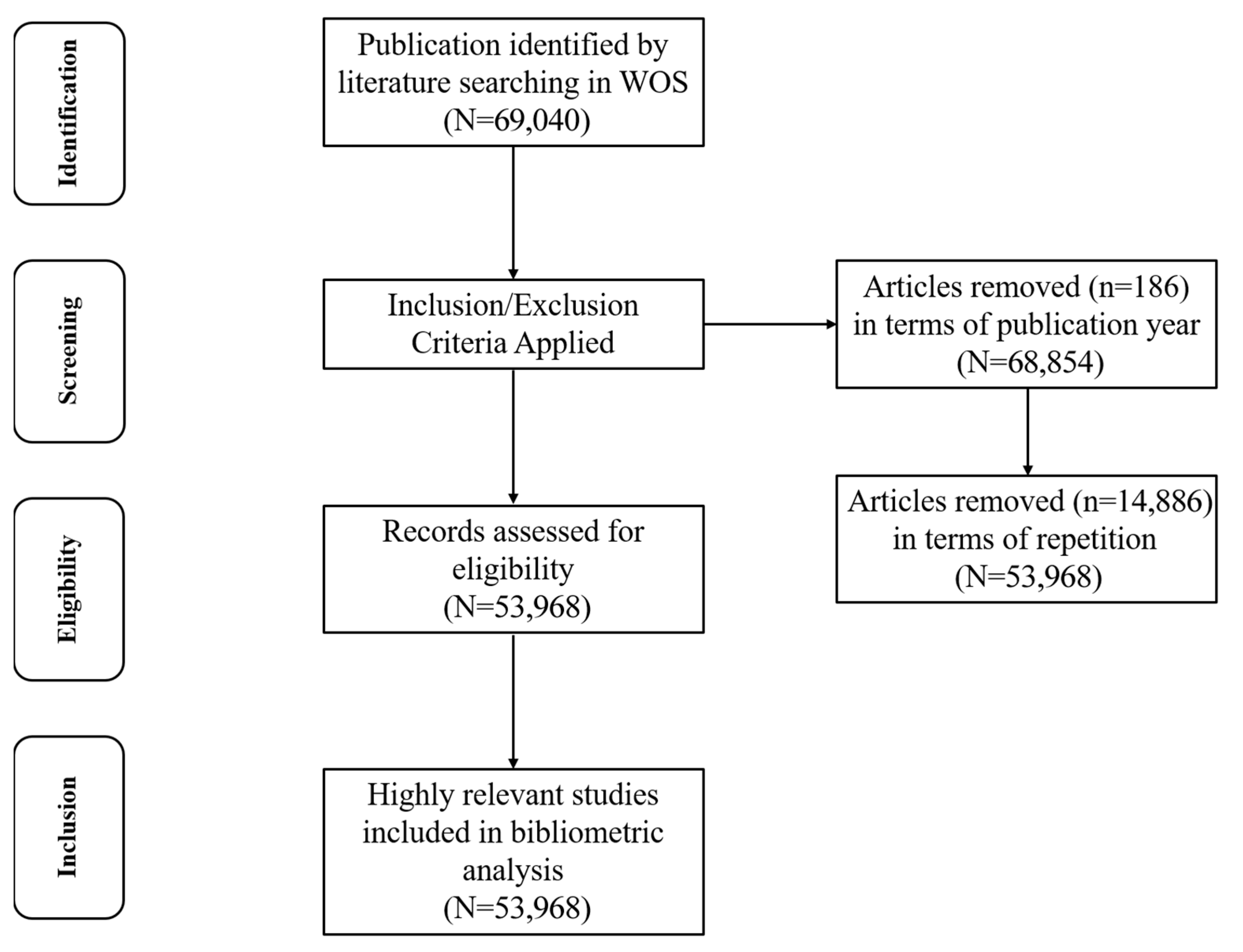

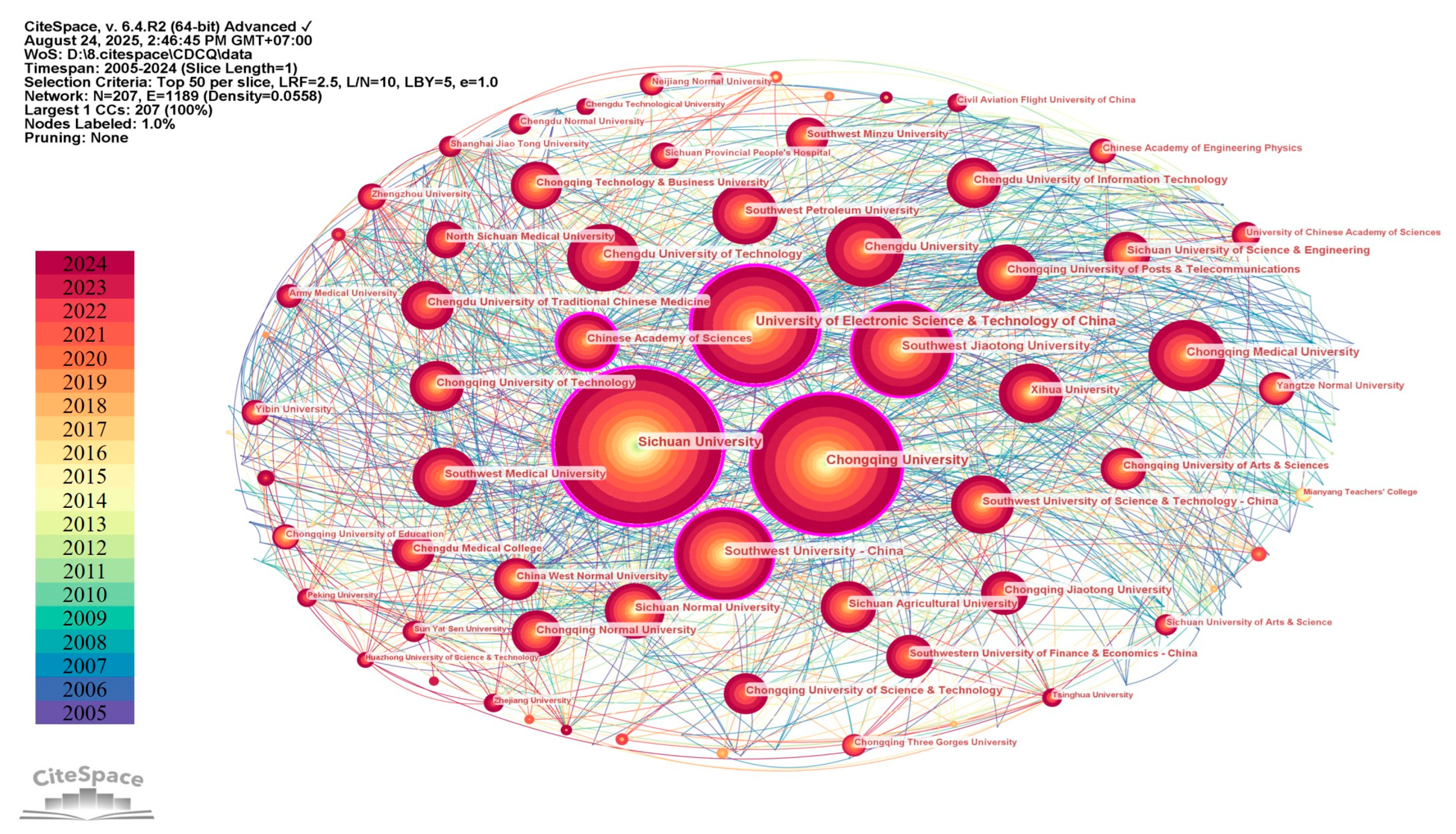
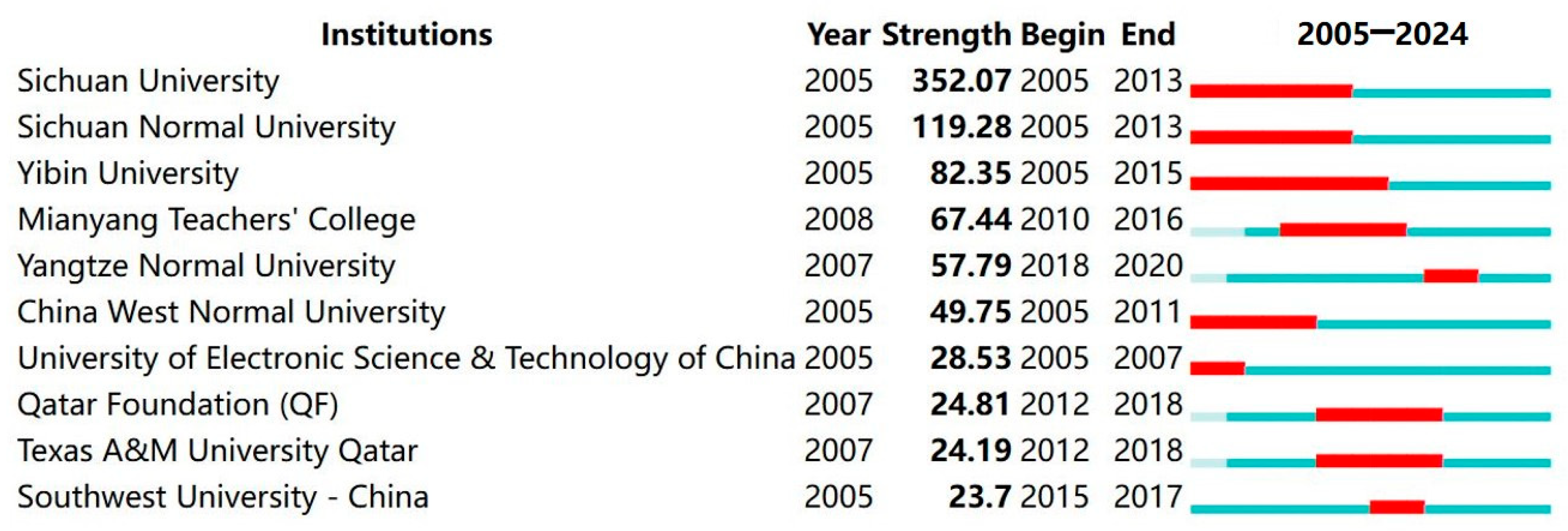
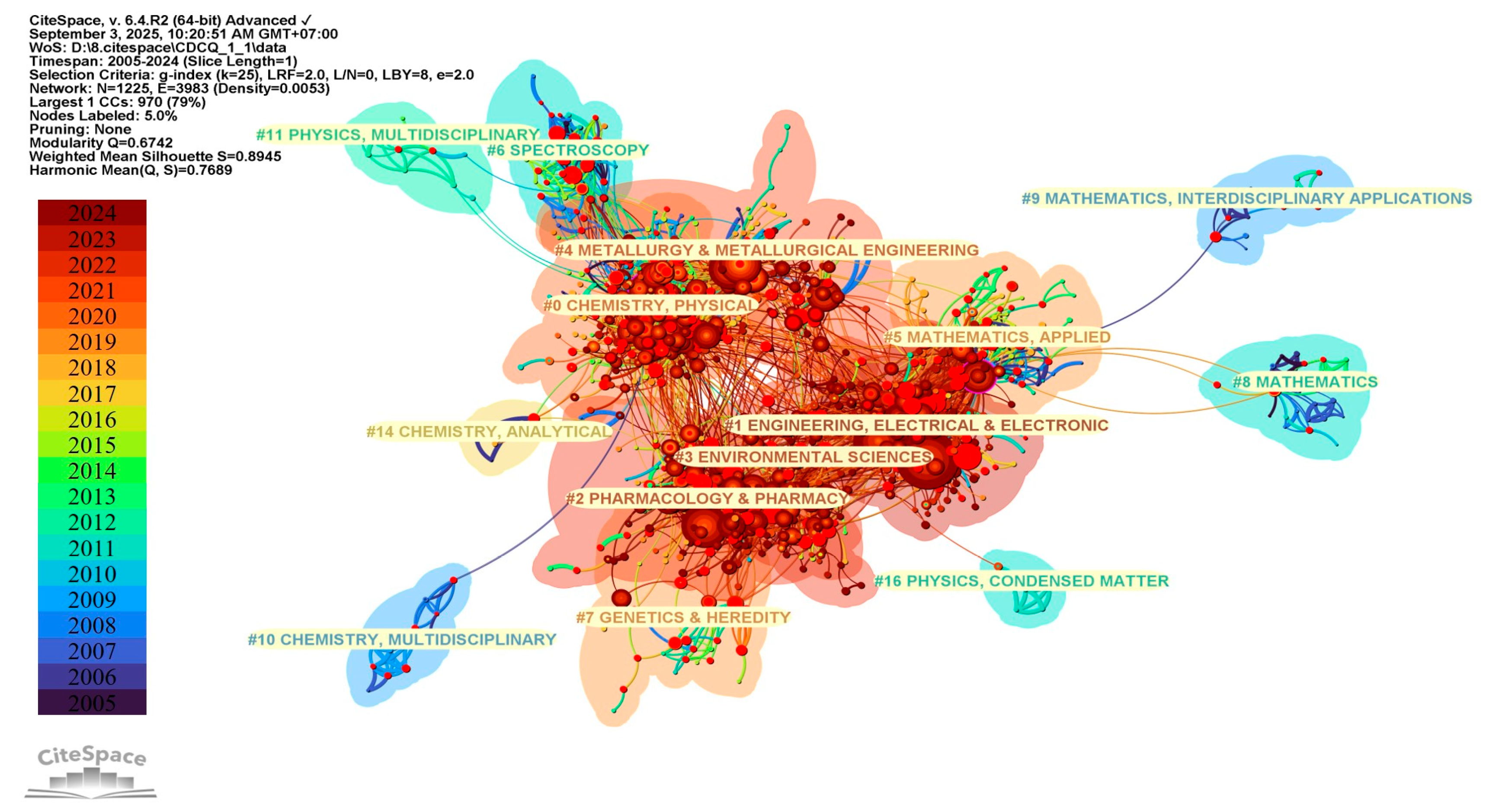


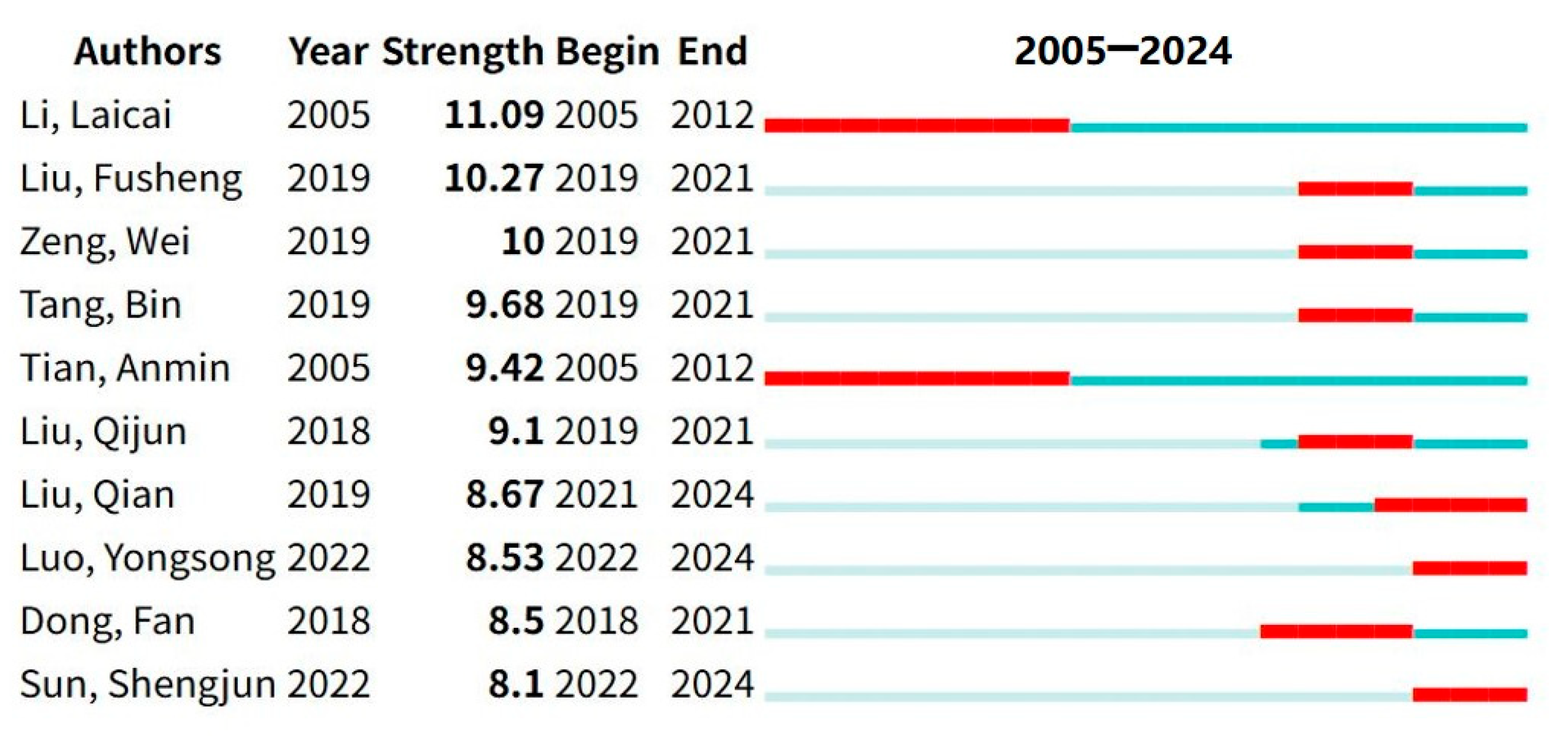


| No. | Publications | Centrality | University |
|---|---|---|---|
| 1 | 16,167 | 0.58 | Sichuan University |
| 2 | 9637 | 0.41 | University of Electronic Science & Technology of China |
| 3 | 12,785 | 0.3 | Chongqing University |
| 4 | 2776 | 0.21 | Chinese Academy of Sciences |
| 5 | 6372 | 0.13 | Southwest Jiaotong University |
| 6 | 6128 | 0.12 | Southwest University—China |
| 7 | 2616 | 0.09 | Chongqing University of Posts & Telecommunications |
| 8 | 2693 | 0.08 | Southwest University of Science & Technology—China |
| 9 | 1680 | 0.05 | China West Normal University |
| 10 | 4032 | 0.05 | Chongqing Medical University |
Disclaimer/Publisher’s Note: The statements, opinions and data contained in all publications are solely those of the individual author(s) and contributor(s) and not of MDPI and/or the editor(s). MDPI and/or the editor(s) disclaim responsibility for any injury to people or property resulting from any ideas, methods, instructions or products referred to in the content. |
© 2025 by the authors. Licensee MDPI, Basel, Switzerland. This article is an open access article distributed under the terms and conditions of the Creative Commons Attribution (CC BY) license (https://creativecommons.org/licenses/by/4.0/).
Share and Cite
Zhang, T.; Tongsri, P.; Ponathong, C. Evolution of Inter-University Research Collaboration in the Chengdu–Chongqing Economic Circle (2005–2024): A Biblio-Metric Perspective. Publications 2025, 13, 56. https://doi.org/10.3390/publications13040056
Zhang T, Tongsri P, Ponathong C. Evolution of Inter-University Research Collaboration in the Chengdu–Chongqing Economic Circle (2005–2024): A Biblio-Metric Perspective. Publications. 2025; 13(4):56. https://doi.org/10.3390/publications13040056
Chicago/Turabian StyleZhang, Tao, Prachuab Tongsri, and Chakrit Ponathong. 2025. "Evolution of Inter-University Research Collaboration in the Chengdu–Chongqing Economic Circle (2005–2024): A Biblio-Metric Perspective" Publications 13, no. 4: 56. https://doi.org/10.3390/publications13040056
APA StyleZhang, T., Tongsri, P., & Ponathong, C. (2025). Evolution of Inter-University Research Collaboration in the Chengdu–Chongqing Economic Circle (2005–2024): A Biblio-Metric Perspective. Publications, 13(4), 56. https://doi.org/10.3390/publications13040056






